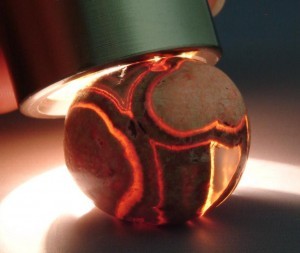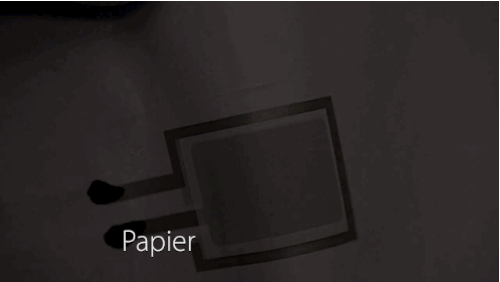#electroluminescence
Brighter flexible electroluminescent film by adopting eye structure of nocturnal animals
A research team led by Dr. Byeong-dae Choi of DGIST’s Intelligent Devices and Systems Research Group has developed an electroluminescent film that is four times brighter than existing ones. The new film can improve the luminance of electroluminescent devices by 422 percent compared to conventional ones by applying retro-reflection electrodes that adapt the principle of nocturnal animal eyes.
Electroluminescent (EL) refers to an optical and electrical phenomenon in which a material emits light in response to the passage of an electric current. Electroluminescent films using phosphor powder have advantages such as excellent durability in a deformed state due to flexibility and elasticity, and high efficiency despite low cost. However, it was difficult to put into practical use due to their low brightness.
In order to increase the brightness of electroluminescent devices, the research team paid attention to the eyes of nocturnal animals with high utilization efficiency of light. The researchers used the retro-reflection characteristics that the light returns to the light source without being dispersed in the retroreflective structure of the nocturnal animal eye while it is scattered in the normal reflection structure.
Post link
Though you may not have heard of them, electroluminescent lamps are everywhere. EdisonTechCenter on YouTube describes how an EL Lamp works, how they are made, what they are made of, and where we see these kind of lamps in everyday life, as well as the history of electroluminescence.
Types of Luminescence
Despite the numberof typesof luminescencealready covered, there are still several more to talk about.
Electroluminescence is when light is emitted due to the passage of an electric current or a strong electric field and is usually seen in semiconductors (such as LEDs). Electroluminescent technologies use relatively low power, though at high voltage, and can be quite thin. This form of luminescence is responsible for the two central images shown above, as well as the Indiglo feature available in many watches.
Similar to electroluminescence, cathodoluminescence is a form of luminescence in which electrons impact a luminescent material and cause the emission of photons which may have wavelengths in the visible spectrum and is mainly seen in semiconductors. One well known example is in cathode ray tubes in televisions. Optical cathodoluminescence microscopes can be used similarly to scanning electron microscopes to examine internal structures of materials.
Radioluminescence occurs by bombardment of materials with ionizing radiation such as beta particles. It is used in applications where light must be produced for long periods without external energy sources. The upper left hand images are illuminated using radioluminescence.
Thermoluminescence is a form of luminescence that is exhibited by certain crystalline materials when previously absorbed energy is re-emitted as light upon heating of the material. It is not the same as black body radiation, when a material glows due to heating. It’s main application is in dating buried objects that have been heated in the past, such as pottery. The upper right image and bottom image illustrate thermoluminescence.
Finally, crystalloluminescence is luminescence produced during crystallization, but it has not been widely studied and not much is known about it.
Sources:Electroluminescence,Cathodoluminescence,Radioluminescence,Thermoluminescence,Crystalloluminescence
Post link
Glowing Paper & Clear Film Bring Flexible Electronics Closer
Light-emitting paper and film have been created in China and Germany, signalling another advance of flexible electronics that will one day be worn on the sleeve or folded up and stuffed in a pocket.
At the Karlsruhe Institute of Technology, engineers have improved on the process of making a material called electroluminescent foil, which glows when current flows through it. They say they can now directly print electroluminescent layers onto other materials like paper and plastic. Their pad-printing process can even be used to layer the film onto convex, concave or other three-dimensional surfaces.
“Any type of three-dimensional object can be provided with electroluminescent coatings at low costs,” said Rainer Kling, a senior scientist at KIT’s Light Technology Institute.
Post link
Time‑correlated single‑photon counting technique to visualize weak pulse electroluminescence
Time‑correlated single‑photon counting (TCSPC) technique is a powerful way to measure the weak light signals. The basic principle behind TCSPC is the photoelectric effect in which an electrical charge is released by absorbing a photon. Compared to the traditional strategy of detecting analog photogenerated voltage, the TCSPC technique counts the single electron pulse created by single photons, which means its sensitivity can be up to single-photon level as its name implies. In fact, the TCSPC technique has been successfully employed to detect the transient/burst photoluminescence (PL) in many research fields, and the transient spectrometer is common equipment in many labs.
Dr. Xianfeng Qiao and Prof. Dongge Ma at South China University of Technology (SCUT), China, are interested in device physics of organic optoelectronics/spintronics devices. Specifically, they pay attention to both transient PL and electroluminescence (EL) profiles, which together provide a wealth of information about how devices work.
Post link









